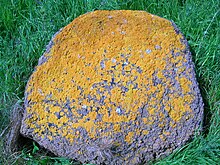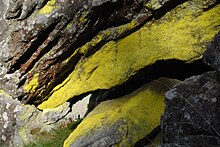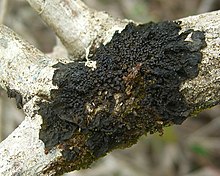
Back Korsmos Afrikaans أشنيات Arabic خز ARY Lique AST Mirapakon ATJ Şibyələr Azerbaijani داشجاباغی AZB Kerpė BAT-SMG Лішайнікі Byelorussian Лішайнікі BE-X-OLD

A lichen (/ˈlaɪkən/ LY-kən, UK also /ˈlɪtʃən/ LITCH-ən) is a hybrid colony of algae or cyanobacteria living symbiotically among filaments of multiple fungi species, along with yeasts and bacteria[1][2] embedded in the cortex or "skin", in a mutualistic relationship.[3][4][5][6][7] Lichens are the lifeform that first brought the term symbiosis (as symbiotismus[8]) under biological context.
Lichens have since been recognized as important actors in nutrient cycling and producers which many higher trophic feeders feed on, such as reindeer, gastropods, nematodes, mites, and springtails.[9][10][11][12] Lichens have properties different from those of their component organisms. They come in many colors, sizes, and forms and are sometimes plant-like, but are not plants. They may have tiny, leafless branches (fruticose); flat leaf-like structures (foliose); grow crust-like, adhering tightly to a surface (substrate) like a thick coat of paint (crustose);[13] have a powder-like appearance (leprose); or other growth forms.[14]
A macrolichen is a lichen that is either bush-like or leafy; all other lichens are termed microlichens.[4] Here, "macro" and "micro" do not refer to size, but to the growth form.[4] Common names for lichens may contain the word moss (e.g., "reindeer moss", "Iceland moss"), and lichens may superficially look like and grow with mosses, but they are not closely related to mosses or any plant.[6]: 3 Lichens do not have roots that absorb water and nutrients as plants do,[15]: 2 but like plants, they produce their own nutrition by photosynthesis.[16] When they grow on plants, they do not live as parasites, but instead use the plant's surface as a substrate.
Lichens occur from sea level to high alpine elevations, in many environmental conditions, and can grow on almost any surface.[16][17] They are abundant growing on bark, leaves, mosses, or other lichens[15] and hanging from branches "living on thin air" (epiphytes) in rainforests and in temperate woodland. They grow on rock, walls, gravestones, roofs, exposed soil surfaces, rubber, bones, and in the soil as part of biological soil crusts. Various lichens have adapted to survive in some of the most extreme environments on Earth: arctic tundra, hot dry deserts, rocky coasts, and toxic slag heaps. They can even live inside solid rock, growing between the grains (endolithic).
There are about 20,000 known species.[18] Some lichens have lost the ability to reproduce sexually, yet continue to speciate.[15][19] They can be seen as being relatively self-contained miniature ecosystems, where the fungi, algae, or cyanobacteria have the potential to engage with other microorganisms in a functioning system that may evolve as an even more complex composite organism.[20][21][22][23] Lichens may be long-lived, with some considered to be among the oldest living things.[6][24] They are among the first living things to grow on fresh rock exposed after an event such as a landslide. The long life-span and slow and regular growth rate of some species can be used to date events (lichenometry). Lichens are a keystone species in many ecosystems and benefit trees and birds.[25]
- ^ Grube, Martin; Cardinale, Massimiliano; de Castro, João Vieira; Müller, Henry; Berg, Gabriele (1 September 2009). "Species-specific structural and functional diversity of bacterial communities in lichen symbioses". The ISME Journal. 3 (9): 1105–1115. Bibcode:2009ISMEJ...3.1105G. doi:10.1038/ismej.2009.63. ISSN 1751-7362. PMID 19554038.
- ^ Grube, Martin; Berg, Gabriele (August 2009). "Microbial consortia of bacteria and fungi with focus on the lichen symbiosis". Fungal Biology Reviews. 23 (3): 72–85. Bibcode:2009FunBR..23...72G. doi:10.1016/j.fbr.2009.10.001.
- ^ Spribille, Toby; Tuovinen, Veera; Resl, Philipp; Vanderpool, Dan; Wolinski, Heimo; Aime, M. Catherine; Schneider, Kevin; Stabentheiner, Edith; Toome-Heller, Merje (21 July 2016). "Basidiomycete yeasts in the cortex of ascomycete macrolichens". Science. 353 (6298): 488–92. Bibcode:2016Sci...353..488S. doi:10.1126/science.aaf8287. ISSN 0036-8075. PMC 5793994. PMID 27445309.
- ^ a b c Lepp, Heino (7 March 2011). "What is a lichen?". Australian National Botanic Gardens. Archived from the original on 2 July 2014. Retrieved 10 October 2014.
- ^ "Introduction to Lichens – An Alliance between Kingdoms". University of California Museum of Paleontology. Archived 22 August 2014 at the Wayback Machine.
- ^ a b c Brodo, Irwin M. and Duran Sharnoff, Sylvia (2001) Lichens of North America. ISBN 978-0300082494.
- ^ "Yeast emerges as hidden third partner in lichen symbiosis". ScienceDaily. 21 July 2016. Retrieved 31 March 2024.
- ^ Frank, A.B. (1877). "Über die biologischen Verkältnisse des Thallus einiger Krustflechten. Beiträge zur Biologie der Pflanzen". HathiTrust. Retrieved 2 November 2024.
- ^ Kumpula, Jouko; Lefrère, Stéphanie C.; Nieminen, Mauri (1 January 2004). "The Use of Woodland Lichen Pasture by Reindeer in Winter with Easy Snow Conditions". Arctic. 57 (3). doi:10.14430/arctic504. ISSN 1923-1245.
- ^ Fröberg, Lars; Baur, Anette; Baur, Bruno (January 1993). "Differential herbivore damage to calcicolous lichens by snails". The Lichenologist. 25 (1): 83. doi:10.1017/s002428299300009x. ISSN 0024-2829.
- ^ Leinaas, Hans Petter; Fjellberg, Arne (June 1985). "Habitat Structure and Life History Strategies of Two Partly Sympatric and Closely Related, Lichen Feeding Collembolan Species". Oikos. 44 (3): 448. Bibcode:1985Oikos..44..448L. doi:10.2307/3565786. ISSN 0030-1299. JSTOR 3565786.
- ^ Gerson, U. (October 1973). "Lichen-Arthropod Associations". The Lichenologist. 5 (5–6): 434–443. doi:10.1017/S0024282973000484. ISSN 0024-2829. S2CID 85020765.
- ^ Cite error: The named reference
ANBGLGwas invoked but never defined (see the help page). - ^ Margulis, Lynn; Barreno, EVA (2003). "Looking at Lichens". BioScience. 53 (8): 776. doi:10.1641/0006-3568(2003)053[0776:LAL]2.0.CO;2.
- ^ a b c Sharnoff, Stephen (2014) Field Guide to California Lichens, Yale University Press. ISBN 978-0-300-19500-2
- ^ a b Cite error: The named reference
LLHEwas invoked but never defined (see the help page). - ^ Sisson, Liv; Vigus, Paula (2023). Fungi of Aotearoa: a curious forager's field guide. Auckland, New Zealand: Penguin Books. p. 66. ISBN 978-1-76104-787-9. OCLC 1372569849.
- ^ Cite error: The named reference
UCLSwas invoked but never defined (see the help page). - ^ Lendemer, J. C. (2011). "A taxonomic revision of the North American species of Lepraria s.l. that produce divaricatic acid, with notes on the type species of the genus L. incana". Mycologia. 103 (6): 1216–1229. doi:10.3852/11-032. PMID 21642343. S2CID 34346229.
- ^ Cite error: The named reference
TTwas invoked but never defined (see the help page). - ^ Cite error: The named reference
FESMwas invoked but never defined (see the help page). - ^ Cite error: The named reference
SSSFDwas invoked but never defined (see the help page). - ^ Cite error: The named reference
NPBwas invoked but never defined (see the help page). - ^ Cite error: The named reference
Morris2007was invoked but never defined (see the help page). - ^ "Lichen - The Little Things That Matter (U.S. National Park Service)". www.nps.gov. Retrieved 17 November 2023.





